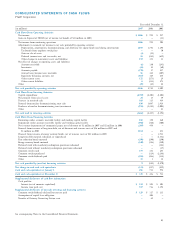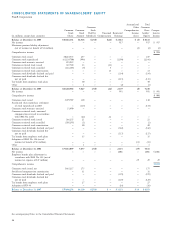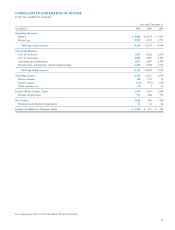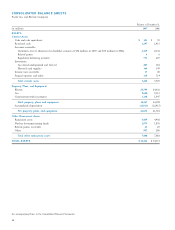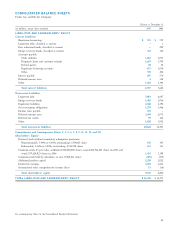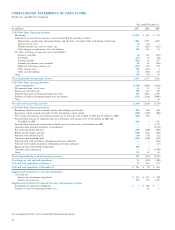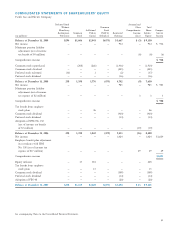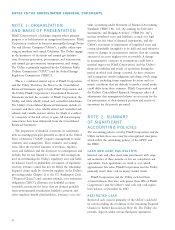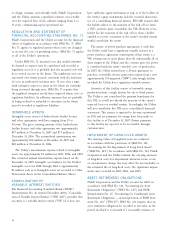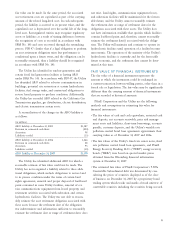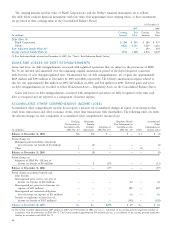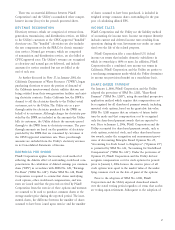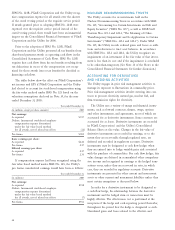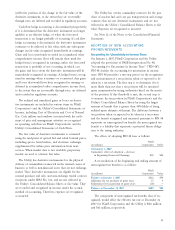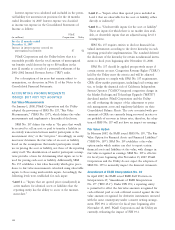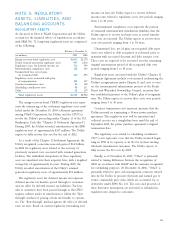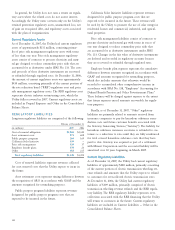PG&E 2007 Annual Report Download - page 96
Download and view the complete annual report
Please find page 96 of the 2007 PG&E annual report below. You can navigate through the pages in the report by either clicking on the pages listed below, or by using the keyword search tool below to find specific information within the annual report.94
to design, estimate, and schedule work. PG&E Corporation
and the Utility amortize capitalized software costs ratably
over the expected lives of the software ranging from 3 to
15 years, commencing upon operational use.
REGULATION AND STATEMENT OF
FINANCIAL ACCOUNTING STANDARDS NO. 71
PG&E Corporation and the Utility account for the fi nancial
effects of regulation in accordance with SFAS No. 71. SFAS
No. 71 applies to regulated entities whose rates are designed
to recover the costs of providing service. SFAS No. 71 applies
to all of the Utility’s operations.
Under SFAS No. 71, incurred costs that would otherwise
be charged to expense may be capitalized and recorded as
regulatory assets if it is probable that the incurred costs will
be recovered in rates in the future. The regulatory assets are
amortized over future periods consistent with the inclusion
of costs in authorized customer rates. If costs that a regu-
lated enterprise expects to incur in the future are currently
being recovered through rates, SFAS No. 71 requires that
the regulated enterprise record those expected future costs as
regulatory liabilities. In addition, amounts that are probable
of being credited or refunded to customers in the future
must be recorded as regulatory liabilities.
INTANGIBLE ASSETS
Intangible assets consist of hydroelectric facility licenses
and other agreements, with lives ranging from 19 to
40 years. The gross carrying amount of the hydroelectric
facility licenses and other agreements was approximately
$97 million at December 31, 2007 and $73 million at
December 31, 2006. The accumulated amortization was
approximately $32 million at December 31, 2007 and
$28 million at December 31, 2006.
The Utility’s amortization expense related to intangible
assets was approximately $3 million in 2007, 2006, and 2005.
The estimated annual amortization expense based on the
December 31, 2007 intangible asset balance for the Utility’s
intangible assets for 2008 through 2012 is approximately
$3 million each year. Intangible assets are recorded to Other
Noncurrent Assets in the Consolidated Balance Sheets.
CONSOLIDATION OF
VARIABLE INTEREST ENTITIES
The Financial Accounting Standards Board (“FASB”)
Interpretation No. 46 (revised December 2003), “Consolida-
tion of Variable Interest Entities” (“FIN 46R”), provides that
an entity is a variable interest entity (“VIE”) if it does not
have suffi cient equity investment at risk, or if the holders of
the entity’s equity instruments lack the essential characteris-
tics of a controlling fi nancial interest. FIN 46R requires that
the holder subject to the majority of the risk of loss from
a VIE’s activities must consolidate the VIE. However, if no
holder has the majority of the risk of loss, then a holder
entitled to receive a majority of the entity’s residual returns
would consolidate the entity.
The nature of power purchase agreements is such that
the Utility could have a signifi cant variable interest in a
power purchase agreement counterparty if that entity is a
VIE owning one or more plants that sell substantially all of
their output to the Utility, and the contract price for power
is correlated with the plant’s variable costs of production.
In 2007, the Utility entered into a 25-year agreement to
purchase as-available electric generation output from a new
approximately 554-megawatt (“MW”) solar trough facility
in which the Utility has a signifi cant variable interest.
Activities of this facility consist of renewable energy
production from a single facility for sale to third parties.
The Utility is not considered the primary benefi ciary for
this VIE, as it will not absorb the majority of the entity’s
expected losses or residual returns. Accordingly, the Utility
will not consolidate this VIE in its consolidated fi nancial
statements. This project is expected to become operational
in 2011 and no payments for energy have been made to
this facility as of December 31, 2007. Future payments
to this facility are expected to be recoverable through
customer rates.
IMPAIRMENT OF LONG-LIVED ASSETS
The carrying values of long-lived assets are evaluated
in accordance with the provisions of SFAS No. 144,
“Accounting for the Impairment of Long Lived Assets”
(“SFAS No. 144”). In accordance with SFAS No. 144, PG&E
Corporation and the Utility evaluate the carrying amounts
of long-lived assets for impairment whenever events occur
or circumstances change that may affect the recoverability or
the estimated life of long-lived assets. No signifi cant impair-
ments were recorded in 2007, 2006, and 2005.
ASSET RETIREMENT OBLIGATIONS
PG&E Corporation and the Utility account for ARO in
accordance with SFAS No. 143, “Accounting for Asset
Retirement Obligations” (“SFAS No. 143”) and FASB
Interpretation No. 47, “Accounting for Conditional Asset
Retirement Obligations — an Interpretation of FASB State-
ment No. 143” (“FIN 47”). SFAS No. 143 requires that an
asset retirement obligation be recorded at fair value in the
period in which it is incurred if a reasonable estimate of



